Brutal Crime against Rural Life: Collectivisation in the Soviet Union
In order to force through the policy of the collectivisation of agriculture, the Soviet authorities unleashed a wave of repressions in the 1930s. The rural people had to involuntarily enter into the collective farms, so-called "kolkhozes". Prosperous peasants or so-called “kulaks” were to be “liquidated as a class”. This, in turn, resulted in a significant decline of agricultural production and an inability to feed population in many rural areas.
The total collectivisation of agriculture had become Stalin’s idée fixe by the autumn of 1929. This was the result of a long chain of events, which began with the failure of the 1926/1927 grain procurement campaign.
The amount of grain procured by the state in 1927 was considerably less than planned. Was it the plan made by the All-Union Communist Party (Bolsheviks) that was already flawed? Stalin and his supporters were of the opinion that „deliberate sabotage” by the wealthy peasants was the reason behind the failed grain procurement campaign.
The word „sabotage” turned out to be the trigger that started bureaucratic and punitive actions by the party leaders everywhere and allowed them to adopt again the essentially terrorist mindset they had acquired during the Civil War.
Stalin, who by that time had become the party’s supreme leader, started using extraordinary measures in his agricultural policies from January 1928, subjecting the sector to external coercion and direct violence by the state.
Until January 1930, these actions were similar to a war of position with attacks, retreats and counterattacks, all aimed at starving the enemy. The measures taken included imposition of higher taxes on better-off households; forced requisitioning of food, known from the War Communism period, was reintroduced on wealthy peasants; properties were seized and confiscated. Labelling peasants as kulaks, a term that emerged during the Civil War and had been forgotten in the meantime, started to be used again.
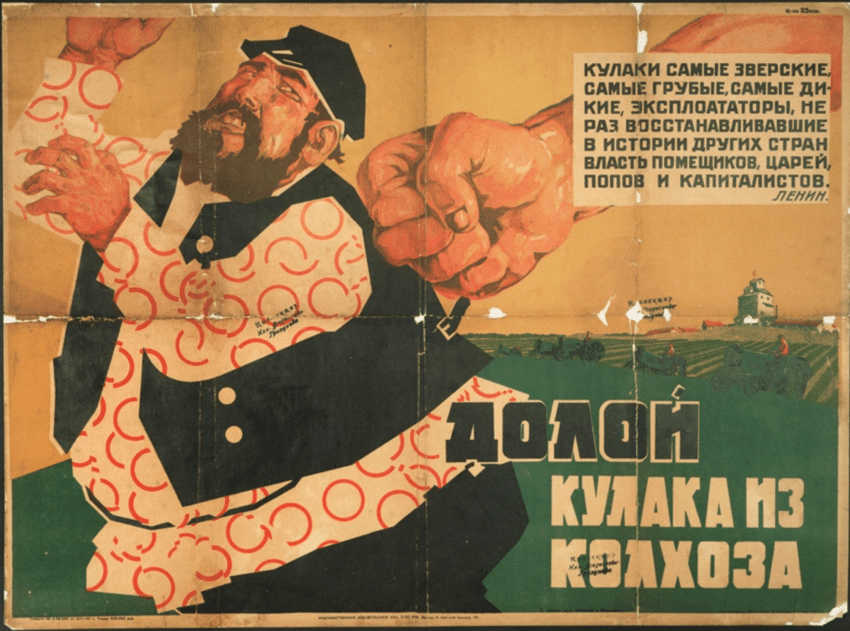
How did the peasants react?
At first, the peasants’ reaction was to resist and revolt. According to the OGPU (Unified State Political Administration), the number of anti-government protests in villages was 709 in 1928, but grew to 1,307 by 1929. The second option was mass exodus – the peasants sold their houses, land and other property and sought a better life in cities, for instance at construction sites, which were part of the first five-year plan. There was a third option, which for many seemed a temporary relief, if not the ultimate way out – the kolkhozes.
Kolkhozes or collective farms had been established in Soviet villages during the war communism years in the form of agricultural cooperatives, artels and communes. It was mostly poor and landless peasants who joined them, for they could not establish their own households.
Despite all the support offered by the state the progress of developing cooperatives in the villages was slow. On 1 October 1927, there were about 18,000 kolkhozes in the whole country, and roughly 200,000 peasant households had joined (out of a total of 25 million farms, i.e. fewer than 0.8%).
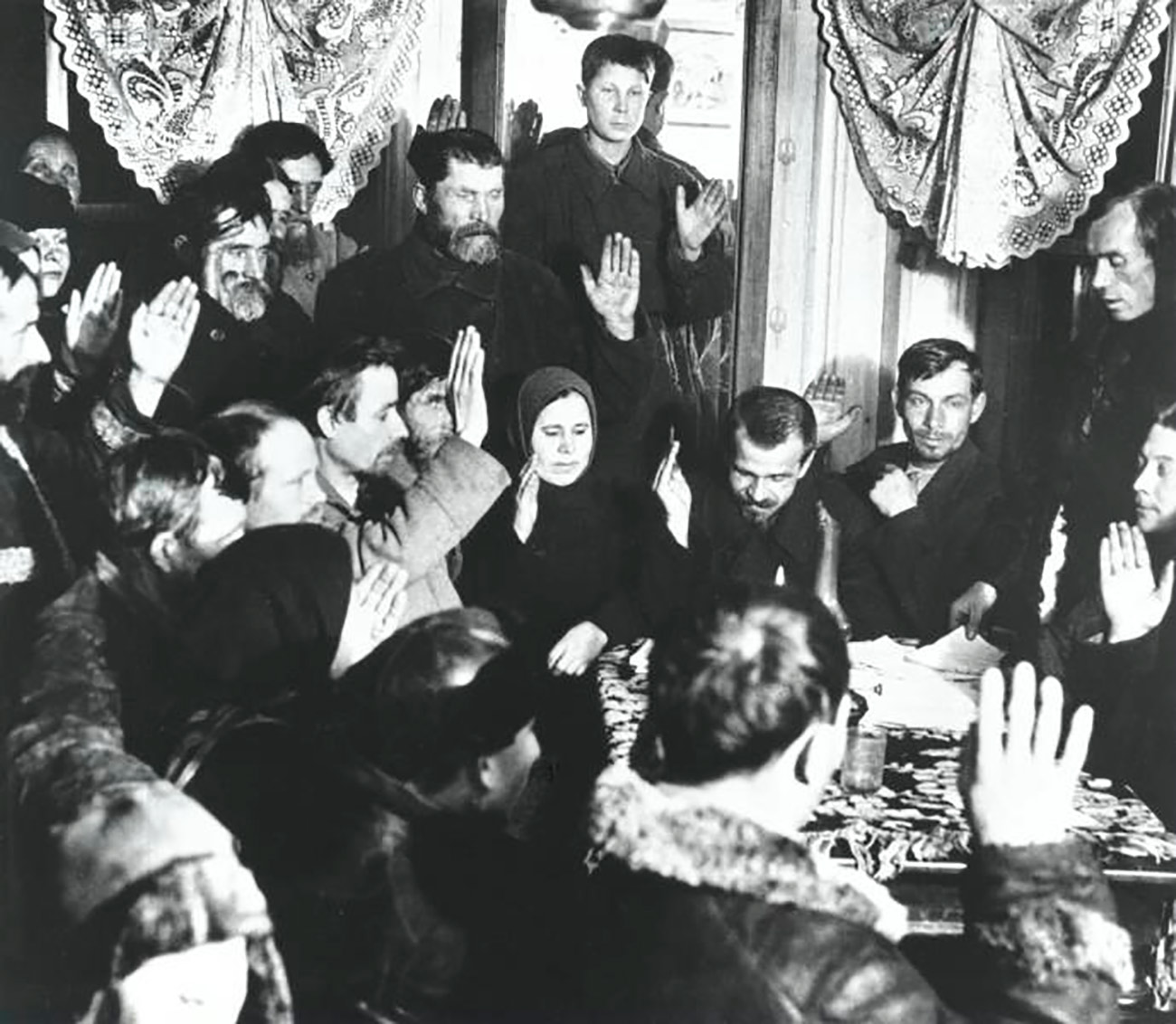
The situation changed dramatically in 1928-1929. By July 1928 the number of kolkhozes had doubled. There were 36,000 kolkhozes now with 400,000 farms joining (constituting 1.7% of the total). It was by no means enough, but still a clear sign of rapid growth.
Obviously, there was nothing voluntary about the whole process. It was an unpleasant move for most of the new collective farm members, especially the more prosperous ones, but it was the only way to survive the systematic destruction of the village life as they knew it.
A characteristic feature of collectivisation was the mass slaughter of cattle that occurred as the peasants joined the kolkhozes in big numbers. From 1929 to 1933 the number of farm animals in the Soviet Union decreased as follows: horses – from 34 million to 16 million, cattle – from 68.3 million to 38.6 million, sheep and goats – from 147.2 million to 50.6 million, and pigs – from 20.9 million to 12.2 million.
Along with the increase in the number of kolkhozes, the local party and Soviet apparatchiks put ever more pressure on the villages in order to produce better and better results. Collectivisation, which had started to resemble a manhunt for peasants, just went on. The higher echelons in the party became convinced that collectivisation was the cure to all agricultural evils.
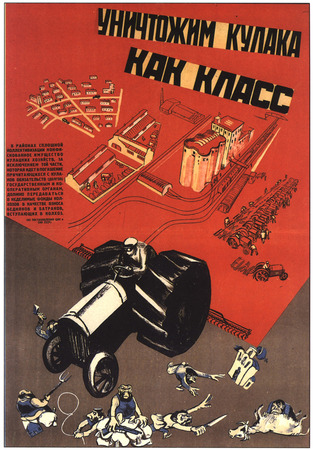
Stalin’s goal was to crash collectivisation at any cost
In 1929 Stalin defeated his last remaining opponents in the Politburo, Bukharin, Rykov and Tomsky, who were against the extraordinary measures and preferred a more moderate policy towards the wealthier peasants. After that Stalin knew that he could dictate his own terms on which direction the state should take.
It soon became clear that the actual policies were even more draconian: ending the New Economic Policy (NEP), forced industrialisation and total collectivisation of agriculture. On 7 November 1929 Stalin published an article in the Pravda newspaper, titled „A Year of Great Change”, reporting „radical change in the development of our agriculture from small, backward, individual farming to large-scale, advanced, collective agriculture, to joint cultivation of the land”.
The Central Committee of the All-Union Communist Party (Bolsheviks) immediately approved the new approach of their leader and came up with the slogan of „complete collectivisation” at their plenary session. With its 5 January 1930 decree the Central Committee also set the deadlines: in the grain-growing regions the change had to occur by autumn 1931 or spring 1932 at the latest.
Labelling farmers as kulaks and expropriation of their property continued to be the main tool of collectivisation. The process was carried out on an unprecedented scale and in completely new ways and formats. Speaking at the Conference of Marxist Students of Agrarian Questions in December 1929, Stalin declared, „we have passed … to the policy of eliminating the kulaks as a class”.
Soon another two documents came out, which were to play a crucial role in the subsequent Soviet history. On 30 January 1930 the Politburo of the Central Committee of the All-Union Communist Party (Bolsheviks) adopted a resolution „on measures to be taken for the liquidation of kulak ownership in complete collectivisation regions”, followed on 2 February by Yagoda’s Operational Directive of the OGPU, No. 44/21.
The resolution divided the kulaks into three categories. Being labelled as kulak, irrespective of the category, meant confiscation of all property (land, housing, cattle, tools, personal possessions, money etc). The fate of the kulaks then depended on the category appointed to them.
Category 1 was made up of „counter-revolutionary kulak activists” – they were sent to concentration camps or shot.
Kulak families belonging to category 2 were expelled to the remotest, uninhabited or sparsely populated areas of the Soviet Union. They had to work in agriculture or industry (forestry, fishery etc). The deportees were placed in smaller villages under the supervision of commandants.
Category 3 kulaks were to stay within the district boundaries, but were transferred to lands outside the kolkhozes. These areas were generally unsuited for tillage, being either too wet, too dry or uncultivated altogether.
The OGPU directive applied to kulaks of category 1 and 2 and regulated the procedure of their arrest, deportation and relocation. According to the directive, troikas (committees made up of three officials) had to be created in the krai and oblast governments to deal with the charges against category 1 kulaks. The families of convicted offenders of category 1 were to be exiled along with the deportees of category 2.
The resolution also set targets for categories 1 and 2, divided between the regions of blanket collectivisation (Ukraine, the Central Black Earth Region, North Caucasus, Middle and Lower Volga, the Urals and Siberia). For category 1 the target figure was 60,000 persons and for category 2 – 150,000 families (i.e. about 750,000 persons). In the remaining regions the numbers were set by the OGPU and local party organisations. The deportees were to be settled in the North Kray, Urals, Siberia and Kazakhstan. No targets were established for category 3 kulaks. However, a control figure of 3-5 percent of the total peasant population was established as the ultimate goal of dekulakization.
Category 1, i.e. arrests, was easy and took little time. Category 2 took somewhat longer, but by the end of 1930, at least 150,000 families had been dispossessed of their properties (including housing) in the regions of complete collectivisation; in other regions 35,000 families suffered a similar fate. The properties of 60,000 families of category 1 arrestees were also confiscated. Altogether, 1.2 million people were affected.
Clearly, the OGPU could not manage resettling such large numbers in the remote regions of the Soviet Union. By the end of 1930, about 112,828 families (550,558 persons) had arrived in their places of exile. The rest were waiting for their fate in collection points or their home villages, provided there were people courageous or compassionate enough to take them in. It could happen that some were left alone altogether or were re-classified as category 3.
According to OGPU data, by August 1930, 51,889 families (about 250,000 persons) had been included in category 3, who were to be resettled within the district boundaries. Most (at least 70%) of the people so relocated escaped from their newly appointed homes to cities, factories or became workers at socialist construction sites. Category 2 peasants, waiting for deportation in their home regions, escaped as well.
A new and hitherto worst wave of deportations stared in 1931. 250,000 families (1.275 million people) were forced to relocate. The numbers consisted of those who had been labelled kulaks in 1930, but were not yet deported, as well as those who were declared kulaks in 1931. In 1932-1933 those who had escaped deportations in earlier years were dealt with. Altogether more than 300,000 people were deported in the course of those two years.
The dekulakization campaign was officially ended on 8 May 1933, when Stalin and Molotov signed a secret instruction, „On Ending the Mass Deportation of Peasants, Revising the Procedure of Arrests and Reducing the Burden of Detention Facilities”. Another 28,300 persons were deported as kulaks in 1934-1935, but this occurred more on a case by case basis.
To sum up, a total of more than 420,000 peasant families (about 2.1 to 2.3 million people) were labelled kulaks from 1930 to 1935. This number does not include the 250,000 category 3 kulaks who were relocated in 1930.
Incidentally, the authorities tried to create the impression that dekulakization was actually a part of the class conflict in villages. The lists of kulaks had to be approved at the meetings of village or landless and poor peasant activists.
There were people almost everywhere who eagerly and with great enjoyment participated in labelling their countrymen kulaks. Some had quite primitive motives: the desire to show off, grudging the more prosperous farmers their success and personal gain. The number of true idealists who really believed in the kolkhoz utopia must have been very small.
Most of the peasants who were lucky not to be made kulaks but could not escape to the cities were forced to join the kolkhozes. By spring 1931, 52% of the peasant households had become members of collective farms, by spring 1933 the number had risen to 64.4% (arable land in collective cultivation was 81.2%).
The reasons why the communist party was so preoccupied with the completion of collectivisation became apparent already during the 1930/1931 grain procurement campaign. Namely, the authorities ordered higher volumes of agricultural products (mainly grain) to be given to the state by the kolkhozes.
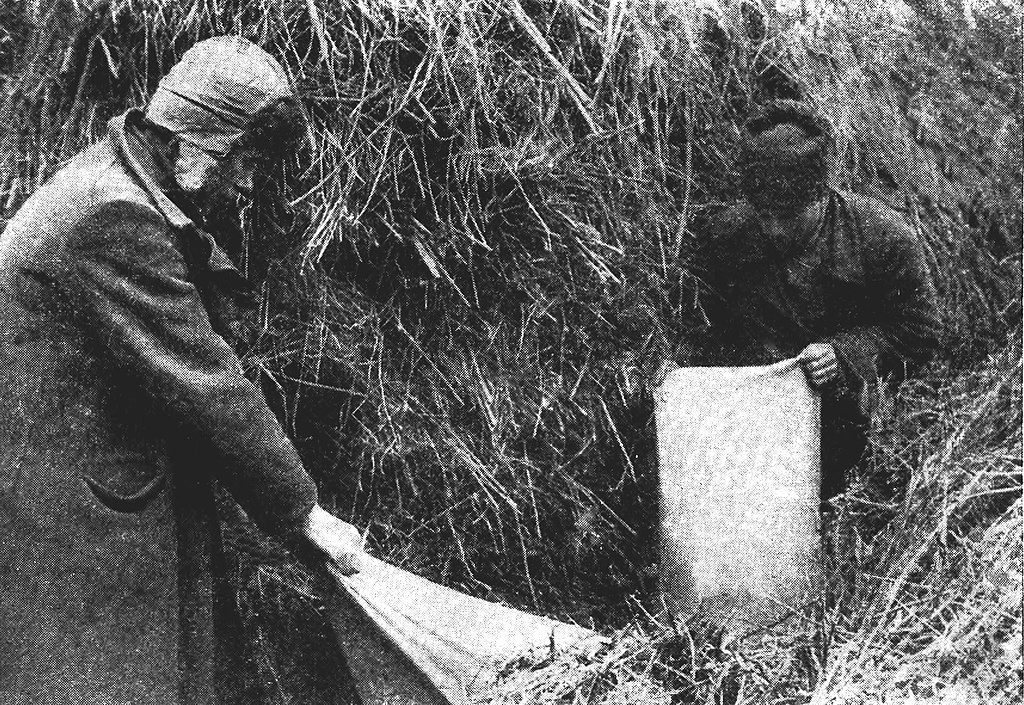
Grain seizures did not leave even the supplies set aside for seed, fodder and food untouched. At the same time a new payment system of normative days was introduced for the collective farm workers: the days were recalculated into food to be allocated for the family only after the kolkhoz plan for agricultural products had been duly fulfilled.
On 7 August 1932, the infamous Decree about the protection of the property of state enterprises, kolkhozes and cooperatives was adopted. It soon became known as the „Law of Spikelets”. The decree proclaimed that the punishment for the starving peasants who hand-collected ears of grain in the collective fields after the harvest was the death sentence, which under extenuating circumstances could be replaced by ten years of incarceration.
Kolkhozes were no longer some kind of bodies of the local government, independent of the state, that could control the results of their activities. They were a form of collective work of the peasants, but they could not enjoy the fruits of their labour, for those belonged solely to the state.
Confiscation of agricultural products from kolkhozes continued and became worse during the 1931/1932 grain procurement campaign, leading to one of the worst humanitarian disasters of the 20th century – the manmade famine of 1932-1933. According to modest estimates of the historians 4-6 million people perished. However, a more detailed discussion of the Holodomor is not the subject of this paper.
By the beginning of 1939 collectivisation in the Soviet Union was almost complete: 93.5% of peasant households and 99.3% of arable land were collectivised. New waves of collectivisation and dekulakization started in 1940-1941 and continued after the war in regions that were annexed by the Soviet Union during the Second World War, i.e. Western Ukraine, Western Belarus, Lithuania, Latvia, Estonia and Bessarabia.
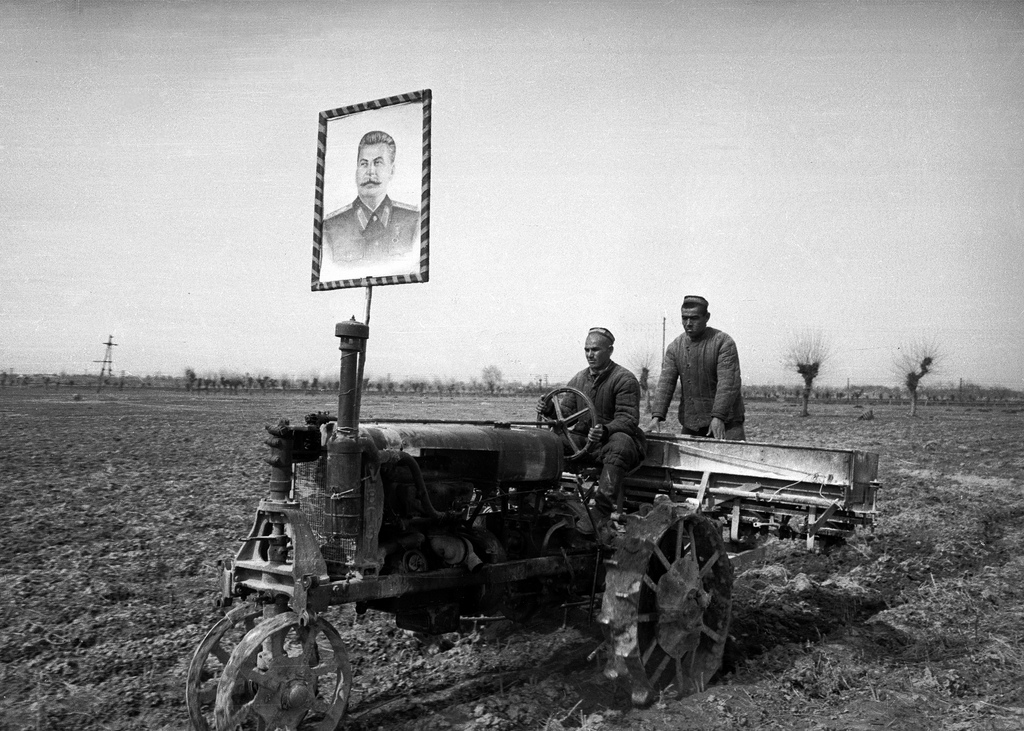
Ultimate goals of collectivisation
Looking at the goal set by the leaders of the All-Union Communist Party (Bolsheviks) to embark on a campaign of restructuring the countryside along socialist principles, one has to admit that collectivisation failed miserably.
Labour productivity in the farming sector fell, the total volume of agricultural production decreased, the living standards of the collective farmers did not improve, people had to suffer the catastrophic famine of 1932-1933, followed by years of misery in the kolkhoz villages.
The process of forced acquisition of resources from the villages for the purposes of industrialisation wasn’t plain sailing either. It turned out to be inadequate and flawed and failed to make the Soviet Union into an advanced industrial power.

However, „the great change” can be viewed from a different angle as well. Based on the experience gained from the 1927-1929 grain procurement campaigns, the Bolsheviks came to realise that what they had perceived to be their unlimited power over the people was actually a fairly arbitrary construct. About 80% of the people, i.e. about 120 million peasants had remained their own masters.
No decree or law could change the fact that these peasants did not depend on the state, because of the inherent logic of the agrarian sector. Namely, the fact that grain for bread, the source of prosperity for the whole country, was produced in millions of individual households.
This was a problem that could be solved in many different ways. N. Bukharin thought that the party approach should be adjusted to bring it in line with economic reality. In Trotsky’s view, villages should be treated as a conquered province: impose permanent taxes and at the same time raid the villages just like the khans used to loot Russian uluses in the old times.
However, starting from December 1927 a third option started gaining ground among the communist elite: relieving the state from the social and economic reality in one go by destroying it and building a new, more desirable reality (even if it looked more like a cardboard mock-up). This option was collectivisation.
It is also understandable why this solution was best suited for the spirit of the era. The idea of bolshevism as the synthesis of political thought and administrative practices was to achieve total control over all aspects of social life.
Of all the possible solutions to bolster their power they instinctively picked the ones that would take care of both current economic problems and strengthen the absolute hegemony of the party and state apparatus. At the end of the 1920s such solutions were Stalin’s dictatorship, ending the New Economic Policy (NEP), and total restructuring of agriculture, based on collectivisation.
Aleksander Daniel (born in 1951) is a Russian mathematician, historian and human rights activist who has worked on problems of Soviet history and studied the roots of dissident activity in the USSR. He has been a long-time associate of the Memorial society.
Bibliography
В.Н. Астров. К текущему моменту. Pravda, 30.09.1928.
Н.И. Бухарин. Заметки экономиста. К началу нового хозяйственного года. Pravda, 30.09.1928.
Н.А. Ивницкий. Голод 1932-1933 в СССР: Украина, Казахстан, Северный Кавказ, Поволжье, Центрально-Черноземная область, Западная Сибирь, Урал. Moscow: Sobranije, 2009. [in English: N.A. Ivnitskiy. The Famine of 1932–1933 in the USSR: Ukraine, Kazakhstan, the North Caucasus, the Volga region, the Central Black Earth region, Western Siberia, the Urals. Moscow: Sobranie, 2009. 286 p]
Н.А. Ивницкий. Коллективизация и раскулачивание (начало 30-х годов). Moscow; Interpraks, 1994.
История сталинского Гулага. Конец 1920-х – первая половина 1950-х годов. Собрание документов в 7-ми т. / Vol 1. Массовые репрессии в СССР. Moscow: ROSSPEN, 2004.
История сталинского Гулага. Конец 1920-х – первая половина 1950-х годов. Собрание документов в 7-ми т. / Vol 5 . Спецпереселенцы в СССР. Moscow: ROSSPEN, 2004.
Как ломали НЭП. Стенограммы пленумов ЦК ВКП(б) 1928—1929 гг. В 5-ти т. - Мoskva: Международный Фонд «Демократия», 2000.
С.А. Красильников. Серп и Молох. Крестьянская ссылка в Западной Сибири в 1930-е годы. М.Moskva: ROSSPEN; Фонд первого президента России Б.Н.Ельцина, 2009
П.М. Полян. Не по своей воле… ... : История и география принудительных миграций в СССР. Moscow: OGI, 2001.
Советская деревня глазами ВЧК—ОГПУ—НКВД. 1918—1939. Документы и материалы. В 4-х т. / Vol 2. 1923—1929. — Мoscow: ROSSPEN, 2000.
Советская деревня глазами ВЧК—ОГПУ—НКВД. 1918—1939. Документы и материалы. В 4-х т. / Vol 3. 1930—1934 гг. Book 1. 1930—1931 гг. — Мoscow: ROSSPEN, 2003.
Советская деревня глазами ВЧК—ОГПУ—НКВД. 1918—1939. Документы и материалы. В 4-х т. / Vol 3. 1930—1934 гг. Book 2. 1932—1934 гг. — Мoscow: ROSSPEN, 2005.
И.В. Сталин. Год великого перелома. К XII годовщине Октября. Pravda, 7.11.1929 [in English: J. V. Stalin. A Year of Great Change. On the Occasion of the Twelfth Anniversary of the October Revolution. Pravda, No. 259,. November 7, 1929].
И.В. Сталин. Головокружение от успехов. К вопросам колхозного движения. Pravda, 2.3.1930 [in English: I.V. Stalin. Dizzy with Success: Concerning Questions of the Collective-Farm Movement. 2 March 1930,” Pravda, 2 March 1930. From J. Stalin, Works, vol. 12 (Moscow, 1955), pp. 197- 205]
И.В. Сталин. К вопросам аграрной политики в СССР. Речь на конференции аграрников-марксистов 27 декабря 1929 г. Pravda, 29,12.1929 [in English: J. Stalin. Problems of agrarian policy in the U.S.S.R. : speech delivered at the Conference of Marxist Students of the Agrarian Question, December 27, 1929, Published by Foreign Languages Publishing House, Moscow, 1952].
И.В. Сталин. Ленин и вопрос о союзе с середняком: ответ тов. С.. Pravda, 3.7. 1928 [in English: J. V. Stalin. Lenin and the Question of the Alliance with the Middle Peasant. Reply to Comrade S. June 12, 1928. Source: Works, Vol. 11, January, 1928 to March 1929].
И.В. Сталин. Отчетный доклад XVII съезду партии о работе ЦК ВКП(б). Moskva: Gospolizdat, 1950 [in English: J. V. Stalin. Report to the Seventeenth Party Congress on the Work of the Central Committee of the C.P.S.U.(B.) January 26, 1934. Source: Works, Vol. 13, 1930]